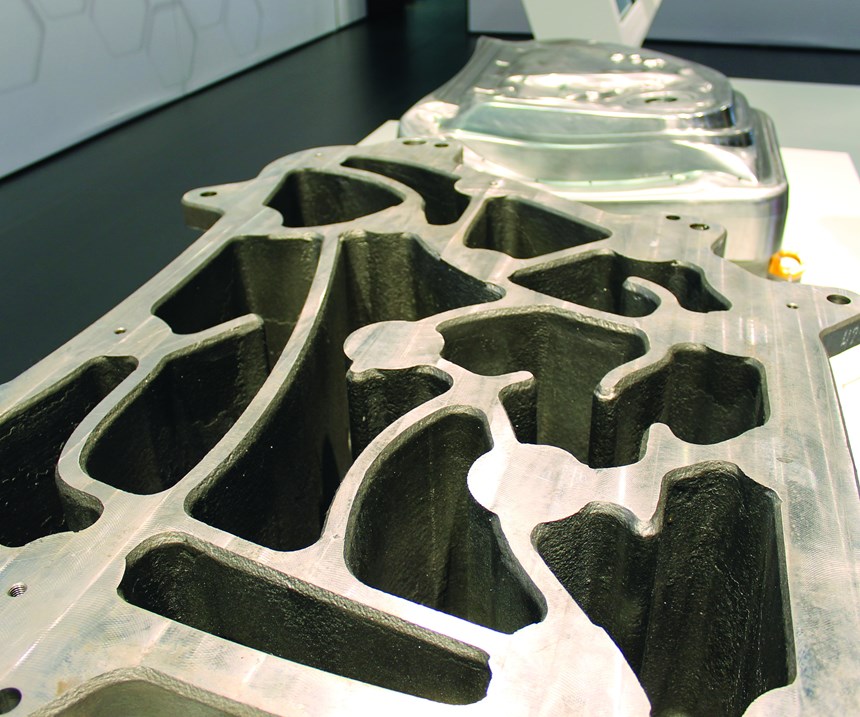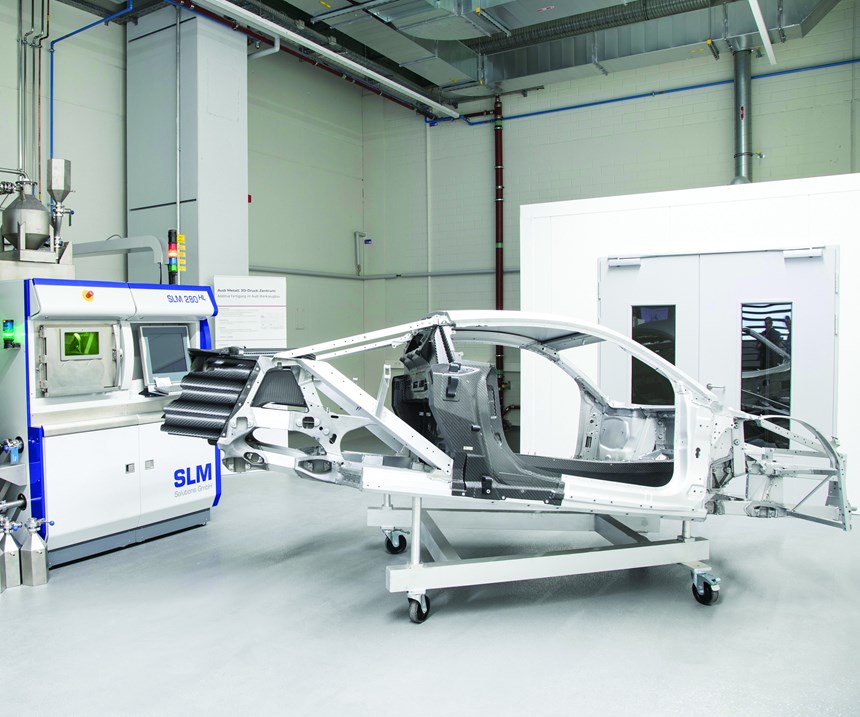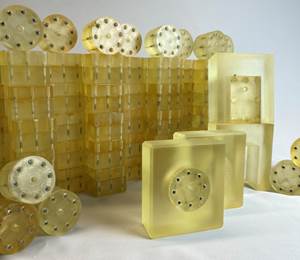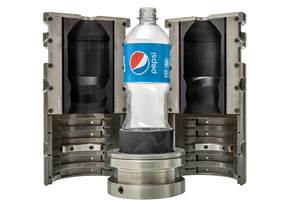Driving a New Generation of Toolmaking
Audi is one car manufacturer making its production—including its toolmaking—fit for the future with Industry 4.0 and metal 3D printing.
Germany is an industrial titan and the eurozone’s economic powerhouse. Its products, especially its cars, stand for quality and high performance. Audi, BMW and Mercedes-Benz account for 80 percent of the global luxury car market. Will Germany still lead the automotive industry when the world shifts to self-driving, electric cars, and software overtakes engines as a vehicle’s most important component? As cars and machines are increasingly mediated by software and digital technologies, will the German automotive industry be left with nothing but panels, windows, seats and wheels?
Probably not. German manufacturers work not only on electric mobility and new drive concepts, but on a future of networked factories and connected robots that are deployed in fully automated production as well.
Audi’s Smart Factory
Audi is one car manufacturer making its production—including its toolmaking—fit for the future. At Audi Techday Smart Factory in Ingolstadt, Germany, in November 2016, Audi said that in its so-called “smart factory,” big data (the creation and intelligent connection of large volumes of data) will facilitate data-driven and thus highly flexible and highly efficient manufacturing. In a smart factory, machinery and equipment can improve processes through automation and self-optimization. The structure of the smart factory includes a combination of production, information and communication technologies with the potential for integration across the entire manufacturing supply chain.
For example, Audi no longer builds its cars on an assembly line. Audi implemented this change in response to a growing model of diversity, which makes it increasingly complicated to master the complexity in a rigid sequential process. Instead, Audi uses a method called modular assembly. The idea behind modular assembly is production without assembly lines, broken down into individual work stages. One or two workers occupy the new assembly stations. They work steadily and at a continuous pace, because they no longer need to adapt their activities to the speed of the line. And, workers do not have to move with the car on a conveyor; they can work in one place.
In addition to this major venture, Audi is pursuing many other exciting production projects, from virtual reality glasses to metal 3D printing. These projects take place at the Audi Toolmaking division in Ingolstadt, Germany. Audi Toolmaking covers the entire process chain of sheet metal production. The division supplies Audi as well as other brands of the Volkswagen Group with dies, molds and manufacturing equipment. Audi Toolmaking currently employs more than 2,000 people at its current five locations in Ingolstadt (Germany), Neckarsulm (Germany), Barcelona (Spain), Győr (Hungary) and Beijing (China). Apart from Beijing, each location produces its own tools, bodyshells and fixtures. Nearly every Volkswagen Group brand uses Audi’s dies.
Audi’s unique design, including its sharp edges and tight tolerances, differentiates its cars and production process from many other car manufacturers around the globe. Jörg Spindler, head of Audi Toolmaking, says that “the only way to achieve those complex geometries is through a close cooperation between our toolmaking, design and production departments. It’s also essential that know-how from the production team is directly fed back to the early design stages. The production of every car starts in the press shop, involving immense forces and highly complex functions. Approximately 750,000 parts are produced at the four Audi press shops worldwide.”
The press shop and toolmaking group have always worked closely together at Audi. The Competence Center for Plan Equipment and Forming Technology, which unites the two divisions, has further intensified their collaboration since January 2017.
Toolmaking at Its Core
“Toolmaking has always been one of Audi’s core competences,” Spindler says. “We are constantly pushing the boundaries of what is technically feasible to lay the foundation for our high‑quality car bodies and to remain globally competitive.”
This dedication earned the team the “Toolmaker of the Year” award in 2015, which is annually awarded by a jury in Aachen, Germany. Specifically, Audi Toolmaking’s diverse innovations impressed the jury. Features like intelligent tools that independently control themselves (to safeguard the precision of sheet metal parts measured in hundredths of millimeters), new lightweight dies and metal additive manufacturing (AM) all impressed the panel.
Intelligent tools. Intelligent tools are equipped with sensors that automatically control the flow of material. Sensors make the process inside the tool visible, identifying how the material is flowing and what forces are being exerted on the blank. This data shows whether the processes are remaining within the narrow window that the engineers have defined. If not, an actuator in the tool autonomously adjusts the distribution of forces within the tool. This enables Audi to ensure precision to within hundredths of a millimeter.
A computer manages the work that the intelligent tool performs and receives its information from up to 24 sensors, such as laser sensors that measure flange feed with extreme precision using triangulation. “In this way, we exploit all physical possibilities of the forming process,” Spindler says. “We are currently using intelligent tools in 12 vehicle projects and five more are planned.” Audi is currently working on using the data from intelligent tools as well as systems that detect part quality to consequently track all pressed parts to have the capacity to react quickly to changes in body construction, for instance.
Light tools. Presses are among the heaviest machines in the production process and can weigh up to 45 tons. The massive dies to deep-draw door panels, for instance, add to the overall weight. They have a large, repetitive and reciprocating movement, which increases a press’s mass dynamics. A lighter tool reduces the dynamics so that momentum and vibration decrease and precision increases. As a result, Audi engineers are now applying new lightweight-construction methods for their tools and dies. The design of the cast-iron housing now follows bionic principles, where free shapes that are reminiscent of natural geometries, such as those found in leaves or skeletons, ensure a lighter, optimized design. Furthermore, some components are made of aluminum and plastics. This reduces the overall weight by as much as 20 percent and the energy requirement by about 10 percent.
A conventional press tool’s load-bearing structure is usually designed conservatively. Part of the framework includes massive horizontal and vertical struts between the lower and upper panels of the base, which cross at right angles and are designed to resist compression. Their design is adapted as well as possible to the special loads acting on the tool in the press. The vertical ribs provide stiffening where the strongest forces act. With the deep drawing process or first stage of forming, those forces can be up to 20,000 kilo newtons.
Audi started developing its new generation of tools five years ago. In the first step, the engineers replaced the right-angled struts in the base of the large-scale tools, which are up to 5 meters long and 2.5 meters wide, with arc-shaped structures. In the second step, they designed free shapes reminiscent of natural geometries. Some of the struts are twisted, others change their profile several times over their lengths. As a result, the new tools are, on average, about 10 percent stiffer and, in some cases, 40 percent lighter than conventional tools.
With no detrimental effects on quality, this allows the number of strokes in the press, which is between nine and 18 per minute, to be increased by one to two. The bottom line is that about 10 percent less energy is required for the press process and for the transportation between tool changes. Audi’s specialists estimate that the use of each new tool, assuming it has a lifetime of seven years, can reduce CO2 emissions by an average of at least 10 percent.
Additive manufactured, optimized design. Additive manufacturing offers similar design optimizations for car components, tools and molds. The Audi Toolmaking division is home to a newly established Metal 3D Printing Center. Here, specialists from Audi Toolmaking collaborate closely with experts from the Casting Technical Center of Production Planning in Ingolstadt. There, 15 casting engineers from Neckarsulm and Ingolstadt develop new technologies and produce small series magnesium and aluminum die-cast parts like chassis components. The center hosts two cold chamber die-casting plants as well as aluminum and magnesium smelting systems.
In cooperation with the Technical Development division, the Casting Technical Center uses its three metal printers to produce steel and aluminum parts for testing in engines and suspension. The Technical Development division in Ingolstadt houses nearly 9,000 employees at its approximately 82.8-acre complex. Another 1,700 employees work in Neckarsulm.
With 3D metal printers in the Casting Technical Center, the goal is to better understand printed aluminum materials and the production technology. Various automobile parts are produced, like space-frame components that integrate fluid containers and suspension components. Also, Audi has recently entered a development partnership with EOS. “With their additive manufacturing technology, we can integrate internal structures and functions in tools that has not been possible with conventional manufacturing. Now we can quickly and economically produce components using lightweight construction, especially with components in small batches,” Spindler says.
Additionally, Audi will focus on producing parts and vehicle components more cost-effectively with inserts for die casting molds and hot-forming tools that use conformal cooling. This optimized cooling performance can reduce cycle time by 20 percent, decreasing energy consumption and cost.
Audi’s toolmaking division is well prepared for future challenges. The entire industry faces enormous challenges in the fields of powertrains and digitization, and Audi is not resting on its laurels.
Related Content
3D Printing Enables Better Coolant Delivery in Milling Operations
Just like 3D printing enabled conformal cooling channels in molds, additive manufacturing is now being used to optimize coolant delivery in cutting tools.
Read MoreIn "Hybrid" FIM Process, 3D Printing Complements Injection Molding
Alpine Advanced Materials used a desktop 3D printer and the freeform injection molding process to reduce prototype tooling production time and cost for its customers.
Read MoreMMT Chats: 4 Keys to a Successful Mold-Building Operation: Innovation, Transparency, Accessibility and Relationship
MoldMaking Technology Editorial Director Christina Fuges chats with Steve Michon, co-owner of Zero Tolerance in Clinton Township, Michigan, about the excitement of solving problems, the benefits of showing gratitude, the real struggle with delegation and the importance of staying on top of technology. This episode is brought to you by ISCAR with New Ideas for Machining Intelligently.
Read MoreHow Hybrid Tooling Accelerates Product Development, Sustainability for PepsiCo
The consumer products giant used to wait weeks and spend thousands on each iteration of a prototype blow mold. Now, new blow molds are available in days and cost just a few hundred dollars.
Read MoreRead Next
How to Use Strategic Planning Tools, Data to Manage the Human Side of Business
Q&A with Marion Wells, MMT EAB member and founder of Human Asset Management.
Read MoreReasons to Use Fiber Lasers for Mold Cleaning
Fiber lasers offer a simplicity, speed, control and portability, minimizing mold cleaning risks.
Read More













.jpg;maxWidth=300;quality=90)









